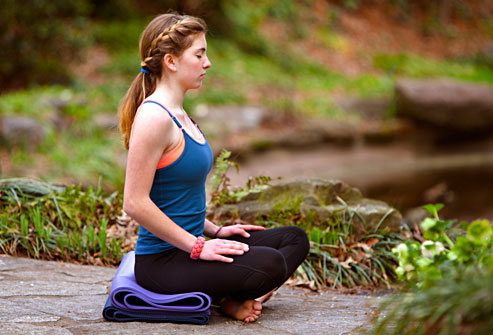Menu
Research shows that breath awareness is among the most effective and accessible tools for self-regulation and calming the nervous system. You can activate the rest-and-digest (the parasympathetic nervous system) yourself. Slow down your exhalations, or breathe in but remember to breathe out even longer (maybe purse your lips and imagine making a candle flicker). Here’s an easy breath practice to reduce stress.

An increasing number of studies show that mindfulness meditation can help ease stress. Meditation encourages us to witness our emotions from a distance rather than getting caught up in them. Furthermore, researchers theorize that yoga might activate the relaxation response via the vagus nerve. This is the nerve that helps control the parasympathetic nervous system. This theory suggests that yoga’s combination of slow movement and conscious breathing initiates a calming response in the nervous system.
Physical activity increases the body’s production of endorphins. These are the brain’s “happy” chemicals. According to the American Psychological Association, exercise forces the body’s physiological systems to communicate much more closely than usual. Therefore, this creates greater efficiency in responding to stress. Moreover, doing a physical activity you enjoy can increase feelings of mastery and self-confidence. Therefore, choose something you like to do so that exercise won’t feel like a chore. Maybe play table-tennis, take the dog out for a run on the beach, go for a swim or hit the dance floor!
It’s possible to change the way we think about stress. We don’t need to see it as such a bad thing.In other words, we can distress into eustress. Alison Wood Brooks, an assistant professor at Harvard Business School, conducted several studies involving karaoke singing, public speaking, and math performance. Surprisingly, the results showed that people who reframed their anxiety as excitement performed better than those who told themselves to stay calm when feeling stressed. According to Brooks, simply telling themselves that they were excited helped them feel more confident and competent. Furthermore, others perceived them that way as well. Think of stressful situations as opportunities to learn and improve.
Whether or not you get enough Zs can have a big impact on stress. One study examined how teenagers reacted during the day when they didn’t get enough sleep at night, as compared to how older adolescents and adults behaved. Scientists found that sleep-deprived teens found stressful situations much more threatening than the older study participants. To improve sleep, make sure your room is dark and cool at night. Turn off your phone and other devices a half hour or more before bed. You might try introducing a relaxing bedtime routine that includes reading, writing in a journal, and/or listening to quiet music. Or try a guided meditation from the Insight Timer app.
There are relaxation techniques that can help teens manage stress. Here are two to try.
Progressive Relaxation
Visualization

Create a Support Network
Multiple studies have shown that social relationships improve mental and physical health. The more support we have, the more resilient we are against stress. Find people you trust who will listen to you and make an effort to understand what you’re going through. Your support network can include family, peers, guidance counselors, and mentors. A mental health professional can also provide support.
The people and places that can help include:
For some people, getting the facts and making plans can help counteract stress. If you have a big project looming, create a schedule that will keep you on track. If you’re facing an unknown situation, do some research so you know what to expect. Arming yourself with information and planning ahead can prepare you to face challenges head on, with more confidence.
If you’re feeling overwhelmed by stress, anxiety, or fear, try this tool. It is used for acknowledging and releasing your emotions and feelings. It’s called “riding the wave.”
Pay attention to your breath and consciously make it slower and deeper.
In conclusion, teens and their parents don’t have to accept stress as a given. The more often teens can activate the parasympathetic nervous system, the more benefits they will feel, in both mind and body.
If you or someone you know are passionate about Wellbeing for Youth? Our next Yoga Ed. Teens Teacher Training is coming up in 2020. This evidence-based training looks at yoga and mindfulness for teenagers as a whole. We’ll explore how yoga tools can support teenagers at school and in the community and how to teach yoga effectively to adolescents. Make sure to enrol early to secure your spot! www.yogazeit.com.au











No spam – just event updates, breathing exercises and free meditation/mindfulness activities.
We won’t pass your details onto third parties. Promise!
© Yogazeit 2019–2023. All rights reserved.
View our Terms and Conditions and Policies and our Guiding Principles.
ABN: 62 631 658 305
Website designed by Eurisko with thanks and gratitude to Lotterywest Grants.
We wish to acknowledge the traditional custodians of the land we are working and living on, the Whadjuk Noongar people.
We acknowledge and respect their continuing culture and the contribution they make to the life, education and mindfulness of this city and this region supported by the leadership of Noongar elders past, present and emerging.
We extend this acknowledgement and respect to all Aboriginal and Torres Strait Islander peoples across Australia.